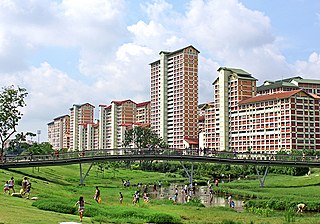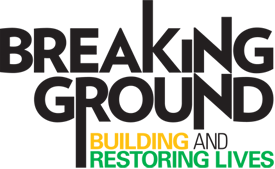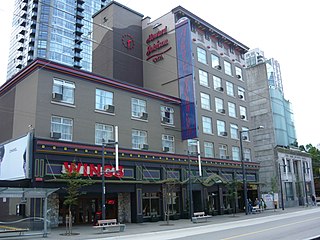Related Research Articles

Public housing is a form of housing tenure in which the property is usually owned by a government authority, either central or local. Although the common goal of public housing is to provide affordable housing, the details, terminology, definitions of poverty, and other criteria for allocation vary within different contexts. Within the OECD, social housing represents an average of 7% of national housing stock (2020), ranging from ~34% in the Netherlands to less than 1% in Colombia.

In the United States, the number of homeless people on a given night in January 2023 was more than 650,000 according to the Department of Housing and Urban Development. Homelessness has increased in recent years, in large part due to an increasingly severe housing shortage and rising home prices in the United States.
Section 8 of the Housing Act of 1937, often called Section 8, as repeatedly amended, authorizes the payment of rental housing assistance to private landlords on behalf of low-income households in the United States. 68% of total rental assistance in the United States goes to seniors, children, and those with disabilities. The U.S. Department of Housing and Urban Development manages Section 8 programs.
Supportive housing is a combination of housing and services intended as a cost-effective way to help people live more stable, productive lives, and is an active "community services and funding" stream across the United States. It was developed by different professional academics and US governmental departments that supported housing. Supportive housing is widely believed to work well for those who face the most complex challenges—individuals and families confronted with homelessness and who also have very low incomes and/or serious, persistent issues that may include substance use disorders, mental health, HIV/AIDS, chronic illness, diverse disabilities or other serious challenges to stable housing.

Affordable housing is housing which is deemed affordable to those with a household income at or below the median as rated by the national government or a local government by a recognized housing affordability index. Most of the literature on affordable housing refers to mortgages and a number of forms that exist along a continuum – from emergency homeless shelters, to transitional housing, to non-market rental, to formal and informal rental, indigenous housing, and ending with affordable home ownership.
Housing First is a policy that offers unconditional, permanent housing as quickly as possible to homeless people, and other supportive services afterward. It was first discussed in the 1990s, and in the following decades became government policy in certain locations within the Western world. There is a substantial base of evidence showing that Housing First is both an effective solution to homelessness and a form of cost savings, as it also reduces the use of public services like hospitals, jails, and emergency shelters. Cities like Helsinki and Vienna in Europe have seen dramatic reductions in homelessness due to the adaptation of Housing First policies, as have the North American cities Columbus, Ohio, Salt Lake City, Utah, and Medicine Hat, Alberta.

Breaking Ground, formerly Common Ground, is a nonprofit social services organization in New York City whose goal is to create high-quality permanent and transitional housing for the homeless. Its philosophy holds that supportive housing costs substantially less than homeless shelters — and many times less than jail cells or hospital rooms, and that people with psychiatric and other problems can better manage them once they are permanently housed and provided with services. Since its founding in 1990 by Rosanne Haggerty, the organization has created more than 5,000 units of housing for the homeless. "This is about creating a small town, rather than just a building," according to Haggerty. "It's about a real mixed society, working with many different people." Haggerty left the organization in 2011 to found Community Solutions, Inc. Brenda Rosen was promoted from Director, Housing Operations and Programs to Executive Director, and has led the organization since.

Homelessness or houselessness – also known as a state of being unhoused or unsheltered – is the condition of lacking stable, safe, and functional housing. The general category includes disparate situations, such as living on the streets, moving between temporary accommodation such as family or friends, living in boarding houses with no security of tenure, and people who leave their domiciles because of civil conflict and are refugees within their country.
Kentucky Housing Corporation (KHC), the Kentucky state housing agency, was created by the 1972 Kentucky General Assembly to provide affordable housing opportunities. KHC is a self-supporting, public corporation.
Launch Housing is a secular Melbourne-based community organisation that delivers homelessness services and housing supports to disadvantaged Victorians.
Non-profit housing developers build affordable housing for individuals under-served by the private market. The non-profit housing sector is composed of community development corporations (CDC) and national and regional non-profit housing organizations whose mission is to provide for the needy, the elderly, working households, and others that the private housing market does not adequately serve. Of the total 4.6 million units in the social housing sector, non-profit developers have produced approximately 1.547 million units, or roughly one-third of the total stock. Since non-profit developers seldom have the financial resources or access to capital that for-profit entities do, they often use multiple layers of financing, usually from a variety of sources for both development and operation of these affordable housing units.

Affordable housing in Canada is living spaces that are deemed financially accessible to those with a median household income in Canada. The property ladder continuum of affordable housing in Canada includes market, non-market, and government-subsidized housing.
Conard House is a 501(c)(3) nonprofit organization based in the SoMa arts district of San Francisco, working to support adults living with serious mental health and medical conditions. The organization's restated mission is "to empower people who live and work on the margins of society."
HOPE Atlanta, the programs of Travelers Aid of Metropolitan Atlanta, is a non-profit organization that has served the metro-Atlanta area for 112 years. Since its inception in 1900, the organization has provided services to over one million people in need throughout the counties surrounding Atlanta, Georgia.

Howard County Housing is the umbrella organization for the Howard County Department of Housing and Community Development and the Howard County Housing Commission. The Department is Howard County Government’s housing agency, and the Commission is a public housing authority and non-profit. Both have boards that meet monthly.

In a study in Western societies, homeless people have a higher prevalence of mental illness when compared to the general population. They also are more likely to suffer from alcoholism and drug dependency. It is estimated that 20–25% of homeless people, compared with 6% of the non-homeless, have severe mental illness. Others estimate that up to one-third of the homeless have a mental illness. In January 2015, the most extensive survey ever undertaken found 564,708 people were homeless on a given night in the United States. Depending on the age group in question and how homelessness is defined, the consensus estimate as of 2014 was that, at minimum, 25% of the American homeless—140,000 individuals—were seriously mentally ill at any given point in time. 45% percent of the homeless—250,000 individuals—had any mental illness. More would be labeled homeless if these were annual counts rather than point-in-time counts. Being chronically homeless also means that people with mental illnesses are more likely to experience catastrophic health crises requiring medical intervention or resulting in institutionalization within the criminal justice system. Majority of the homeless population do not have a mental illness. Although there is no correlation between homelessness and mental health, those who are dealing with homelessness are struggling with psychological and emotional distress. The Substance Abuse and Mental Health Services Administration conducted a study and found that in 2010, 26.2 percent of sheltered homeless people had a severe mental illness.
Homeless veterans are persons who have served in the armed forces who are homeless or living without access to secure and appropriate accommodation.
The Rental Assistance Demonstration is a federal housing program that was enacted as part of the Consolidated and Further Continuing Appropriations Act, 2012, and is administered by the U.S. Department of Housing & Urban Development (HUD). Broadly, the purpose of the Rental Assistance Demonstration is to provide a set of tools to address the unmet capital needs of deeply affordable, federally assisted rental housing properties in order to maintain both the viability of the properties and their long-term affordability. It also simplifies the administrative oversight of the properties by the federal government. Specifically, RAD authorizes the conversion of a property's federal funding from one form to another, where the initial form presents structural impediments to private capital investment and the new form is not only familiar to lenders and investors but, since its enactment in 1974, has leveraged billions in private investment for the development and rehabilitation of deeply affordable rental housing.
Supportive Services for Veteran Families (SSVF) was established by the United States Department of Veterans Affairs (VA) in 2011 to create public-private partnerships to rapidly re-house homeless Veteran families and prevent homelessness for very low-income Veterans at imminent risk due to a housing crisis. SSVF has been led since its inception by John Kuhn, the previous VA National Director of Homeless Evaluation.

In October 2023, an average of 90,578 people slept in New York City's homeless shelters each night. This included 23,103 single adults, 32,689 children, and 34,786 adults in families. The total number is at its highest ever, with 63,636 people sleeping in homeless shelters. The city reported that in 2019, 3,600 individuals experienced unsheltered homelessness, sleeping in public spaces such as streets and public transit rather than shelters. The homeless population has surged in New York City 18% in 2023 from 2022, despite efforts from Mayor Adams.